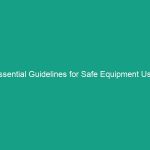Introduction
In the agricultural sector, the use of chemicals is essential for enhancing productivity and controlling pests. However, with the Benefits of these substances come significant risks that require strict adherence to health, safety, and environmental (HSE) guidelines. The importance of Workplace Safety cannot be overstated, particularly when dealing with hazardous materials. This article will delve into the essential guidelines for the handling and storage of agricultural chemicals, ensuring that those involved in agriculture can mitigate risks effectively.
Regulatory Frameworks for Agricultural Chemicals
Understanding the regulatory frameworks surrounding agricultural chemicals is crucial for compliance and Safety. Various organizations, including the Environmental Protection Agency (EPA) in the United States and similar bodies worldwide, set guidelines for the use, storage, and disposal of these materials.
Key Regulations
In the U.S., the Federal Insecticide, Fungicide, and Rodenticide Act (FIFRA) governs the registration, distribution, and use of agricultural chemicals. Under FIFRA, all pesticides must be registered with the EPA, ensuring they are safe for use and do not pose unreasonable risks to human health or the Environment. Additionally, the Occupational Safety and Health Administration (OSHA) provides regulations regarding worker Safety when handling these substances.
International Guidelines
Globally, the Rotterdam Convention and the Stockholm Convention play significant roles in regulating hazardous chemicals. These treaties promote the safe handling and storage of agricultural chemicals, emphasizing the need for informed consent before international trade of hazardous substances. It is vital for agricultural businesses to familiarize themselves with both local and international regulations to ensure compliance and protect public health.
Best Practices for Handling and Storage of Agricultural Chemicals
Implementing Best Practices in the handling and storage of agricultural chemicals is essential for minimizing risks. These practices not only protect workers but also safeguard the environment and the surrounding community.
Personal Protective Equipment (PPE)
Personal protective equipment is a fundamental aspect of safety when dealing with agricultural chemicals. Workers should be equipped with appropriate gear, including gloves, goggles, respirators, and protective clothing. The type of PPE required can vary depending on the chemical being handled. For example, when working with particularly toxic substances, more robust protection may be necessary.
Safe Handling Techniques
Employing safe handling techniques is vital to prevent spills and accidents. Workers should be trained to follow proper Procedures when mixing, applying, and disposing of agricultural chemicals. For instance, it is important to:
- Read and understand the label instructions.
- Use proper measuring tools to avoid over-application.
- Avoid eating, drinking, or smoking in areas where chemicals are handled.
Proper Storage Practices
Storage of agricultural chemicals must be conducted with care to prevent exposure and contamination. Here are key practices to follow:
- Store chemicals in their original containers with labels intact.
- Maintain a well-ventilated storage area, away from direct sunlight and extreme temperatures.
- Keep storage areas secure and accessible only to trained personnel.
Case Studies: Successes and Failures
Examining real-world case studies can provide valuable insights into the handling and storage of agricultural chemicals. Understanding what has worked and what hasn’t can inform future practices.
Successful Implementation of HSE Guidelines
A notable example is a large agricultural cooperative that implemented a comprehensive Training program for its workers. This program focused on the safe handling and storage of chemicals, resulting in a significant reduction in accidents and spills. The cooperative also invested in state-of-the-art storage facilities equipped with spill containment systems, further enhancing safety.
Challenges Faced by Agricultural Businesses
Conversely, a small farm faced severe consequences after failing to adhere to HSE guidelines. An accidental spill of herbicides resulted in extensive damage to nearby water sources, leading to costly fines and remediation efforts. This case highlights the importance of compliance with safety regulations and the potential risks of negligence.
Challenges in Handling and Storing Agricultural Chemicals
Despite the availability of guidelines and regulations, challenges remain in the safe handling and storage of agricultural chemicals. Identifying these challenges is the first step toward developing effective solutions.
Training and Awareness
One of the most significant challenges is ensuring that all workers are adequately trained and informed about the risks associated with agricultural chemicals. Many agricultural workers may lack proper training, leading to unsafe practices. Regular training sessions and refreshers can help maintain a high level of awareness and compliance.
Access to Resources
Access to resources, including PPE and storage facilities, can be another challenge, particularly for smaller farms. Financial constraints may limit the ability to invest in necessary safety equipment. It is crucial for agricultural businesses to seek financial assistance, grants, or partnerships that can provide the resources needed to enhance safety.
Cultural Attitudes Toward Safety
Lastly, cultural attitudes toward safety can impact compliance. In some regions, there may be a perception that safety regulations are burdensome or unnecessary. Changing these attitudes requires ongoing education and advocacy, emphasizing the importance of safety for both workers and the environment.
Future Trends in Agricultural Chemical Safety
The landscape of agricultural chemicals is continuously evolving, influenced by technological advancements and changing regulations. Staying informed about future trends is essential for agricultural professionals.
Innovative Technologies
Emerging technologies, such as precision agriculture and drone applications, are changing how chemicals are applied. These innovations can lead to more efficient use of chemicals, reducing the risk of over-application and minimizing environmental impact. As these technologies become more widespread, training will need to evolve to incorporate new methods and tools.
Increased Regulatory Scrutiny
Regulatory bodies are expected to impose stricter guidelines on the use of chemicals, with a focus on Sustainability and environmental protection. Agricultural businesses must stay informed about these changes to ensure compliance and avoid potential penalties.
Public Awareness and Advocacy
As public awareness of the environmental impacts of agricultural practices grows, there is an increasing demand for transparency and responsibility. Agricultural professionals will need to engage with the community, demonstrating their commitment to Safe Practices in the handling and storage of agricultural chemicals.
Conclusion
In conclusion, the safe handling and storage of agricultural chemicals is a critical component of Workplace Safety and environmental protection. By understanding regulatory frameworks, implementing Best Practices, learning from case studies, addressing challenges, and staying abreast of future trends, agricultural professionals can create a safer working environment. It is essential to prioritize safety, not just for compliance but for the well-being of workers, the community, and the environment. We encourage all stakeholders in agriculture to commit to these guidelines and promote a culture of safety and responsibility.


